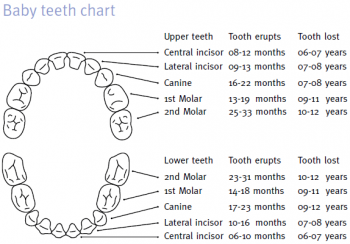When babies start teething
Just like walking and saying their first words, teething is another important milestone in your child’s life. Although seeing the first teeth when your little one smiles is something to be happy about, the process of getting there can be very stressful, for both of you. Teething can cause many uncomfortable symptoms, such as sensitive and swollen gums, drooling, chin rash, gnawing, sleeping problems and more. Still, when your baby starts teething, you can rest assured that their development is on the right track. Tooth development is necessary for your child to eat a well-rounded diet, including solid foods, a prerequisite for full development and a strong immune system. Teething also plays a role in developing language skills – chewing on food actually helps strengthen muscles of the jaw, cheeks, lips and tongue, all of them necessary to be able to speak properly.
When does teething start?
For most babies, the first teeth start appearing around the age of 6 months. However, this milestone is very individual and it can happen as early as 3 months of age and it is not unusual for children as old as 12 months to start developing their first teeth. Even though the timescale for milk teeth is very individual, there are some general rules on when you can expect pairs of teeth to emerge – this is best presented in a teething chart.
When your child gets their first teeth depends mostly on you. If you and your partner experienced teething early, it is likely that your child will as well. The same goes if you were a late teether.
Usually, the first teeth to appear are the two bottom front teeth or central incisors, followed by upper front teeth. Sometimes the teeth follow in different order but almost always in pairs. These teeth normally don’t cause much pain since their edges are very thin and have no problem coming through the gums. Around the time your child turns one, the molars will start appearing (these are the teeth in the back of the mouth). Molars are often much more uncomfortable than incisors, mostly due to their broad surfaces that create a lot of pressure and pain in order to break through the gums.
By the time your little one turns three years old, all milk teeth should be in their place. Around the age of 6 the process starts all over again, with milk or primary teeth falling out and permanent, adult teeth replacing them. This process takes time, with wisdom teeth appearing between the ages of 17 to 21 years of age.
How to relieve the symptoms of teething
As we mentioned at the beginning, teething can be a very unpleasant process. Some babies will show one or no symptoms at all, while others won’t be so fortunate and may cause you many sleepless nights. There are some tried-and-tested remedies that can alleviate some discomfort, such as a gentle massage, chilled teether with teething gel applied to points of contact, or providing your child with a damp and chilled cloth. They will try to stick anything into their mouth, so it’s very important to keep in their reach only the things they are allowed to chew on, and to keep their hands clean to avoid infections. It is always a good idea to have a dribble bib or change of clothes at hand, as drooling can be pronounced and make your little one wet and cold.


